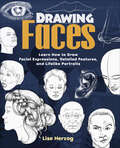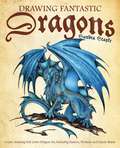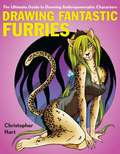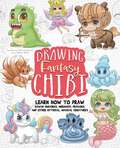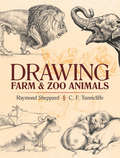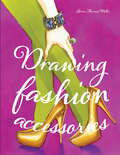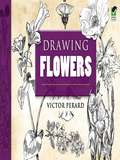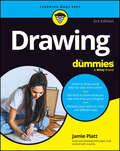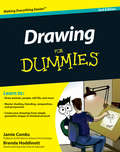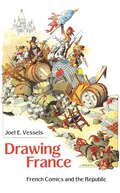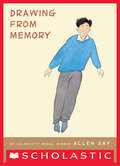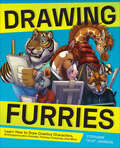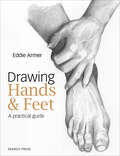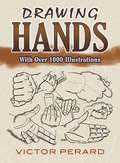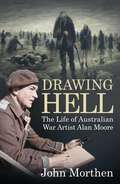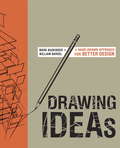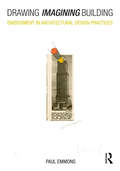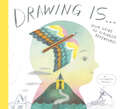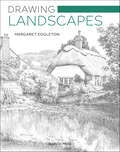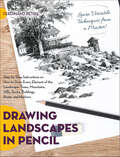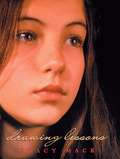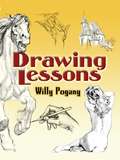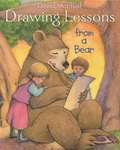- Table View
- List View
Drawing Faces: Learn How to Draw Facial Expressions, Detailed Features, and Lifelike Portraits (How to Draw Books)
by Lise HerzogMake your portraits and character drawings even more realistic with these step-by-step instructions and tips. Grab your sketchbook, pens, and pencils, and follow along as this instructional drawing guide teaches you everything you need to know about creating true-to-life human faces. With more than 150 easy-to-follow illustrations, Drawing Faces is the perfect guide for aspiring artists looking to develop their portrait skills. Start off simple with learning how to draw basic facial features. By the end of the book, you will have gained the knowledge you need to make your characters&’ faces as realistic as possible, including learning to draw: *Various facial expressions *Side profiles *Lifelike portraits *and much more! Whether you&’re a beginner or a drawing pro, Drawing Faces is the perfect book to hone your technical drawing skills and take your illustrations to the next level.
Drawing Fantastic Dragons: Create Amazing Full-Color Dragon Art, including Eastern, Western and Classic Beasts
by Sandra StapleCreate and Customize the Dragon of Your Dreams!If you can dream it, this book will show you how to bring it to life in distinct and dramatic color. With easy-to-follow, step- by-step instructions, Drawing Fantastic Dragons teaches the tricks and techniques to create your own amazing art.Start with a sketch of the dragon&’s body form. Then add the head, tail, arms and legs. Next customize it with one of the many styles of horns, scales, claws and wings detailed in this guide. You will even learn how to add age, personality and animal attributes to your dragon. Lastly, author Sandra Staple shows how to finish your dragon drawing with amazing color effects. Packed with example after example, this hands-on guide features dragons of all shapes and sizes, and includes a special section on how to draw unique beasts like earth, air, and fire dragons, wyverns, hydras, and more.
Drawing Fantastic Furries: The Ultimate Guide to Drawing Anthropomrphic Charaacters
by Christopher HartENTER THE ALLURING, MAGICAL, MYTHICAL WORLD OF THE FURRY KINGDOM What Is A Furry?A furry is an anthropomorphic being--an animal with human characteristics. Furries have fascinated artists going back thousands of years and as seen in the influx of animal/human characters into popular culture, interest today is at an all time high. And now for the first time all in one volume, you'll be able to take the next step to the outer limits of your imagination with the ultimate guide to drawing your own furries--Christopher Hart's Drawing Fantastic Furries. After a basic lesson in the fundamentals of comparative human and animal anatomies, you'll learn how to draw an entire menagerie of furry species, ranging from the adorable and charming super-cute furries to the seductive and super-popular glamorous furries to the warriors, wizards, vampires, and demons of the furry occult and fantasy realms.From the Trade Paperback edition.
Drawing Fantasy Chibi: Learn How To Draw Kawaii Unicorns, Mermaids, Dragons, and Other Mythical, Magical Creatures (How to Draw Books)
by Tessa Creative Art Sarah E. WhiteLearn how to draw adorable, step-by-step anime- and manga-inspired mythical creatures, including chibi mermaids, unicorns, fairies, and more with this easy-to-follow how-to-draw book!Crack open your sketchbook, grab your pens and pencils, and get ready to turn your fantasy illustrations into kawaii (cute) and chibi (small) creatures. With step-by-step instructions and easy-to-follow tips and tricks, this instructional handbook will help you bring a new level of anime style to your sketches. Start with a few familiar fantasy creatures, like a unicorn, mermaid, and dragon, before learning how to transform ancient, lesser-known creatures like the basilisk, oni (Japanese demon), and kraken into adorable chibi versions. Whether you&’re a beginner or a drawing pro, Drawing Fantasy Chibi makes this fun, anime-style drawing easy, with workbook-style pages that provide a space for readers to try their hand at practicing each drawing multiple times before they master it!
Drawing Farm and Zoo Animals (Dover Art Instruction)
by Raymond Sheppard Charles Frederick TunnicliffeFor the first time in a single-volume edition, this guide combines the works of two of Britain's leading 20th-century illustrators of animals, Raymond Sheppard's Drawing at the Zoo and Charles Tunnicliffe's How to Draw Farm Animals. Artists of all skill levels will benefit from the book's tremendous variety of domestic and wild animal studies, each accompanied by helpful pointers.Even the smallest of zoos offers models with an abundant variety of shapes and patterns. It's not always easy to capture animals in motion, so in Drawing at the Zoo, Raymond Sheppard proposes starting with sleeping creatures and the less excitable types to help overcome the practical difficulties. Other suggestions include what not to do, notes on distinctive animal characteristics, and a survey of basic shapes, all illustrated by the author's own work. Charles F. Tunnicliffe, author of How to Draw Farm Animals, grew up on a farm and drew and painted animals all his life. In addition to dozens of fascinating examples of his sketches, his book includes informative comments on farm life that provide essential tips for the realistic portrayals of horses, cattle, pigs, and sheep as well as the farmer's dog and the farmyard cat.
Drawing Fashion Accessories
by Steven Thomas MillerDrawing Fashion Accessories is a practical guide to illustrating footwear, millinery, bags and purses, cosmetic products and jewellery, offering a unique resource for students and professional fashion illustrators alike.Beginning with a discussion of the media available for drawing fashion accessories and how best to use them, together with a demonstration of various art styles, Miller then moves on to demonstrate the technicalities of drawing different products, including the specific challenges of perspective, how to draw accessories on the body, and how to render a wealth of different materials. In addition to the practice of drawing, a series of specially illustrated glossaries introduces readers to the technical and style terminology used throughout the accessories industry.Illustrated with specially created step-by-step sequences, Drawing Fashion Accessories provides students with the knowledge and freedom to develop their own work beyond the basics and to bring style and flair to their illustrations.
Drawing Fashion Accessories
by Steven Thomas MillerDrawing Fashion Accessories is a practical guide to illustrating footwear, millinery, bags and purses, cosmetic products and jewellery, offering a unique resource for students and professional fashion illustrators alike.Beginning with a discussion of the media available for drawing fashion accessories and how best to use them, together with a demonstration of various art styles, Miller then moves on to demonstrate the technicalities of drawing different products, including the specific challenges of perspective, how to draw accessories on the body, and how to render a wealth of different materials. In addition to the practice of drawing, a series of specially illustrated glossaries introduces readers to the technical and style terminology used throughout the accessories industry.Illustrated with specially created step-by-step sequences, Drawing Fashion Accessories provides students with the knowledge and freedom to develop their own work beyond the basics and to bring style and flair to their illustrations.
Drawing Flowers
by Victor PerardA graduate of the École des Beaux-Arts in Paris, acclaimed artist and illustrator Victor Perard emigrated to the United States in the 1930s and taught at New York City's Cooper Union for twenty years. His popular series of art instructional books covers the essentials on drawing -- and his illuminating advice continues to help students and teachers today. In this illustrated guide to drawing Mother Nature's most beautiful flowers, Perard plants seeds of inspiration for artists of every ability. Dozens of black-and-white images highlight various techniques, as he shows how the variety of lines can add texture, light or movement to garden favorites. There are violets, daisies, and daffodils abloom, plus chrysanthemums, lilacs, lilies, and more. With a natural affinity for flowers of every kind, Perard reveals the rewards of this artistic effort -- developing a sense of composition and an eye for balance in design. Includes a list of state flowers.
Drawing For Dummies
by Jamie PlattAnyone can learn to draw with these easy instructions and fun practice ideas Drawing For Dummies makes it easy to learn the basics of drawing and even master advanced techniques. With a little instruction and practice, there’s no such thing as “I just can’t draw.” Drawing can help you relieve stress, express your emotions and creativity, communicate across cultures, improve memory, and develop and strengthen fine motor skills. This user-friendly Dummies resource will teach you how to see the world through the eyes of an artist, explore your inner visions, and open up your creativity through drawing exercises. Step-by-step illustrations and images, newly enlarged in this edition, will show you exactly how to achieve the results you want. It might be time to invest in some picture frames, because you’re about to make art you can be proud of. Learn the fundamentals of drawing, including the essential supplies you’ll need Practice drawing techniques, get your creativity flowing, and explore your own mind with fun drawing exercises Get step-by-step instructions on how to draw anything in a range of styles Improve your abilities with tips and ideas for making your drawings betterComplete beginners and more advanced artists alike will have fun developing their skills with Drawing For Dummies.
Drawing For Dummies, 2nd Edition
by Jamie Combs Brenda HoddinottThe fast and easy way to learn to draw Drawing can enrich your life in extraordinary and unexpected ways. Drawing your everyday experiences can change how you and others see the world, while drawing from your imagination can give rise to fantastic new worlds. And, despite what you may believe, it's something just about anyone can learn to do. Drawing For Dummies offers you a fun, easy way to learn the drawing basics. Holding fast to the simple philosophy that only you can teach yourself to draw, it gives you the tools you need to explore the basics and move on to more advanced techniques. This revised edition of one of the most successful For Dummies guides includes Additional step-by-step instructions for drawing people, animals, still life, and more Coverage of effects, composition, and perspective How-to art projects that show you how to create your drawings from simple geometric shapes to finished artwork It's never too late to unleash the artist within. Let Drawing For Dummies, 2nd edition put you on the road to discovery and self-expression through drawing.
Drawing France: French Comics and the Republic
by Joel E. VesselsIn France, Belgium, and other Francophone countries, comic strips—called bande dessinee or “BD” in French—have long been considered a major art form capable of addressing a host of contemporary issues. Among French-speaking intelligentsia, graphic narratives were deemed worthy of canonization and critical study decades before the academy and the press in the United States embraced comics. The place that BD holds today, however, belies the contentious political route the art form has traveled. In Drawing France: French Comics and the Republic, author Joel E. Vessels examines the trek of BD from it being considered a fomenter of rebellion, to a medium suitable only for semi-literates, to an impediment to education, and most recently to an art capable of addressing social concerns in mainstream culture. In the mid-1800s, alarmists feared political caricatures might incite the ire of an illiterate working class. To counter this notion, proponents yoked the art to a particular articulation of “Frenchness” based on literacy and reason. With the post-World War II economic upswing, French consumers saw BD as a way to navigate the changes brought by modernization. After bande dessinee came to be understood as a compass for the masses, the government, especially Francois Mitterand’s administration, brought comics increasingly into “official” culture. Vessels argues that BD are central to the formation of France’s self-image and a self-awareness of what it means to be French.
Drawing From Memory
by Allen SayCaldecott Medalist Allen Say presents a stunning graphic novel chronicling his journey as an artist during WWII, when he apprenticed under Noro Shinpei, Japan's premier cartoonistDRAWING FROM MEMORY is Allen Say's own story of his path to becoming the renowned artist he is today. Shunned by his father, who didn't understand his son's artistic leanings, Allen was embraced by Noro Shinpei, Japan's leading cartoonist and the man he came to love as his "spiritual father." As WWII raged, Allen was further inspired to consider questions of his own heritage and the motivations of those around him. He worked hard in rigorous drawing classes, studied, trained--and ultimately came to understand who he really is. Part memoir, part graphic novel, part narrative history, DRAWING FROM MEMORY presents a complex look at the real-life relationship between a mentor and his student. With watercolor paintings, original cartoons, vintage photographs, and maps, Allen Say has created a book that will inspire the artist in all of us.
Drawing Furries: Learn How to Draw Creative Characters, Anthropomorphic Animals, Fantasy Fursonas, and More (How to Draw Books)
by Stephanie "Ifus" JohnsonLearn how to design your very own anthropomorphic animal character with this fun and easy-to-use guide.Dive into the fun world of furries with this step-by-step drawing handbook for creating imaginative, anthropomorphic animals like wolves, foxes, dragons, and more!In Drawing Furries, you’ll learn how to sketch the human body, include various shapes and sizes of heads, eyes, and torsos. Then the fun really begins! Using a little creativity and reference images, you’ll start binging your own fursonas to life by adding various elements like cat ears, bear paws, or a wolf snout.Created by professional artist Stephanie “Ifus” Johnson, who specializes in furry art, this is the perfect companion for beginning artists as well as dedicated furry fans.
Drawing Hands
by Carl CheekAn indispensable and easy-to-follow companion for the intermediate art student, this concise guide focuses on how to capture the natural representation of the human hand in all its forms and motions.Over 100 clear and expertly rendered drawings help artists discover:* The subtle but crucial differences between hands of young and old, male and female* How to accurately draw hands engaged in a variety of activities* Skeletal and muscular depictions, which help reveal how to naturally draw the workings of the magnificent human handEducated in England at the Chelsea School of Art and the Royal College of Art, the works of Carl Cheek were widely exhibited in Europe throughout the 1950s. His artwork is included in numerous private and public collections, including Britain's important and often-visited Government Art Collection.
Drawing Hands & Feet
by Eddie ArmerAn essential guide to what is regarded as a challenging subject, this book will simplify and inspire artists to approach drawing hands and feet with precision and confidence. Eddie Armer presents a comprehensive course that will guide the artist through everything from which drawing materials to use, through to mastering proportion, perspective, light and shade. The result will be the accurate portrayal of hands and feet at rest, in motion and performing intricate tasks in a variety of different poses. With his experience, knowledge and love of the subject, Eddie will teach you how to understand the underlying anatomy of the subjects and the whole drawing process with helpful tips and advice, exercises and projects. This is an exhaustive, must-have book, a true masterclass from a true master of the medium, that will inspire any artist who wants to create realistic and characterful drawings of hands and feet.
Drawing Hands: With Over 1000 Illustrations (Dover Art Instruction)
by Victor PerardSecond in importance only to the face, hands play a key role in expressing emotional states—from anger and fear to resignation, serenity, and surprise. This resource features more than 1,000 illustrations, offering figure artists at all skill levels insights into the structure, character, and expression of hands. Artist and instructor Victor Perard emphasizes the anatomy of the hand: the bones that make up its framework and define its proportions and the muscles that direct its actions. In addition to notes on proportion and perspective, he groups the illustrations of hands in a manner that accents the modifications of their form as they are viewed from various angles. The tremendous variety of images ranges from male and female hands engaged in work and leisure activities to the hands of athletes, babies, and the elderly.
Drawing Hell: The Life of War Artist - Alan Moore
by J P Morthen"From the sweltering battlefields of the South Pacific to the devastated cities of Europe, Alan Moore witnessed the greatest war in human history—not with a rifle, but with a paintbrush."As an official war artist with the RAAF, Moore was sent deep into the action, capturing history as it unfolded. He documented the brutal Japanese counterattack at Los Negros Island, the perilous missions of airmen dodging flak over Eastern Europe, and the harrowing reality inside one of Nazi Germany&’s most infamous concentration camps. With his camera, sketchbook, and oil paints, he recorded not just battles, but the human cost of war—the exhaustion, the fear, the destruction, and the small moments of resilience that defined a generation. Yet despite his remarkable body of work, Alan Moore remains one of Australia&’s forgotten artists. His paintings, raw and unfiltered, serve as powerful reminders of the horrors of war, ensuring that the sacrifices of those who served are never lost to history. Through meticulous research and rare archival materials, Drawing Hell unearths the story of a man whose work still hangs in some of the world&’s most prestigious museums and galleries. Moore&’s life spanned a century of conflict, change, and artistic evolution, yet his story has remained largely untold—until now. In this gripping account, historian John Morthen brings Moore&’s legacy back into the spotlight, revealing how his art shaped the way we remember war. For those who believe history should never be forgotten, Drawing Hell is an essential read.
Drawing Ideas
by Mark Baskinger William BardelA primer for design professionals across all disciplines that helps them create compelling and original concept designs by hand--as opposed to on the computer--in order to foster collaboration and win clients. In today's design world, technology for expressing ideas is pervasive; CAD models and renderings created with computer software provide an easy option for creating highly rendered pieces. However, the accessibility of this technology means that fewer designers know how to draw by hand, express their ideas spontaneously, and brainstorm effectively.In a unique board binding that mimics a sketchbook, Drawing Ideas provides a complete foundation in the techniques and methods for effectively communicating to an audience through clear and persuasive drawings.
Drawing Imagining Building: Embodiment in Architectural Design Practices
by Paul EmmonsDrawing Imagining Building focuses on the history of hand-drawing practices to capture some of the most crucial and overlooked parts of the process. Using 80 black and white images to illustrate the examples, it examines architectural drawing practices to elucidate the ways drawing advances the architect’s imagination. Emmons considers drawing practices in the Renaissance and up to the first half of the twentieth century. Combining systematic analysis across time with historical explication presents the development of hand-drawing, while also grounding early modern practices in their historical milieu. Each of the illustrated chapters considers formative aspects of architectural drawing practice, such as upright elevations, flowing lines and occult lines, and drawing scales to identify their roots in an embodied approach to show how hand-drawing contributes to the architect’s productive imagination. By documenting some of the ways of thinking through practices of architectural handdrawing, it describes how practices can enrich the ethical imagination of the architect. This book would be beneficial for academics, practitioners, and students of architecture, particularly those who are interested in the history and significance of hand-drawing and technical drawing.
Drawing Is ...: Your Guide to Scribbled Adventures
by Elizabeth HaidleAn inspiring and affirming book on drawing and how to think about drawing, for kids and all curious humans ages 8 and up. For fans of Wreck This Journal, Wreck This Picture Book and Making Comics.What happens when you pick up a pencil? How do you talk to yourself about drawing while you're drawing? Where do your scribbles start and where do they lead? Are you ready to find out?With acclaimed art and editorial director of Illustoria and author-illustrator Elizabeth Haidle as your guide through the world of art, Drawing Is . . . is an essential and captivating guide to drawing, brimming with artful exercises and perfect for anyone seeking a creative adventure.If you've ever picked up a pencil, drawn, stopped drawing, started again, doodle without purpose, sketched with intention, been disappointed with your art and thrown it out, yet turned the page to try a new experiment . . . this book is for you.All you need is a drawing surface. A drawing tool. A dot. And a line. Whatever your skill level, you're invited to draw along.
Drawing Landscapes
by Margaret EggletonArtists of all skill levels will find much to inspire them in this detailed and practical guide to drawing landscapes. Margaret Eggleton guides you through easy-to-follow drawing stages, and gives advice on using sketchbooks, line and tone, perspective and more. She shows how to draw elements of the landscape such as trees and foliage, hills and mountains, skies, water and buildings, and there are practical, step-by-step exercises throughout to help you practise the techniques.Margaret then guides you carefully through each stage of six stunning projects, each culminating in a beautiful landscape drawing you'll be proud of. Suitable for beginners wanting to build up their confidence as well as more seasoned artists seeking inspiration, this book is a must-have for anyone who wants to draw landscapes in dry media such as graphite pencils, acrylic ink, pen, Conté crayons, pastels or charcoal.This is a new, redesigned edition of Margaret's highly successful Drawing Masterclass: Landscapes.
Drawing Landscapes in Pencil
by Ferdinand PetrieComprehensive and insightful, Ferdinand Petrie's Drawing Landscapes in Pencil is full of invaluable lessons in the subtle art of pencil drawing. The course begins with a thorough overview of materials and fundamental pencil-handling skills before progressing meticulously through a series of lessons about value, form, texture, and smudging techniques. With dozens of the author's own works included as references and examples, the remaining chapters focus on rendering specific elements of landscapes like hills, trees, bodies of water, reflections, houses, cities, and more. A wonderful guide for beginners and advanced artists alike, Drawing Landscapes in Pencil will teach you to unlock the potential of the pencil.
Drawing Lessons
by Tracy MackTwelve-year-old Rory begins to lose the passion for making art that she shares with her father after she finds him kissing his female model and fears for the safety of her parents' marriage.
Drawing Lessons
by Willy PogányIn this essential guide to the basic principles of drawing the human figure, Pogany--one of the leaders of the Golden Age of Illustration--shows readers the path to artistic mastery. With a warm and supportive tone, he seamlessly blends instruction and insight with 375 masterful illustrations. The aim: to build a foundation for those who wish to draw skillfully and easily.Beginning with the humble dot and moving forward to perspective, anatomy, shading, portraiture, balance, motion, and more, this step-by-step resource is a genuine inspiration. Details of the human head, eyes, ears, and feet add depth to the instruction, followed by simple demonstrations that clearly illustrate how fundamental techniques are put into practice. Easy to follow and concise, this guide has long been considered an important resource for artists of all abilities.
Drawing Lessons from a Bear
by David M. Mcphail"You can't be a bear, you know, but you can be an artist. Are you an artist? Then say so. Say it softly to yourself, or say it loudly for the whole world to hear: I AM AN ARTIST! There. Now you are an artist. For all time and forever." From his earliest scratchings on the floor of his den to his drawings for kings and queens and princesses, this down-to-earth bear artist guides and encourages young readers to follow their dreams. Support from his mom (who hangs his first pictures on the wall of the den with magnetic rocks) and his teacher, as well as inspiration from art museums and the world around him, create an environment where the fuzzy artist can learn and grow. Warmly humorous text by David McPhail, the beloved human artist and author of more than 50 children's books (including Edward and the Pirates), will inspire bears and human beings alike to pursue their artistic aspirations.
